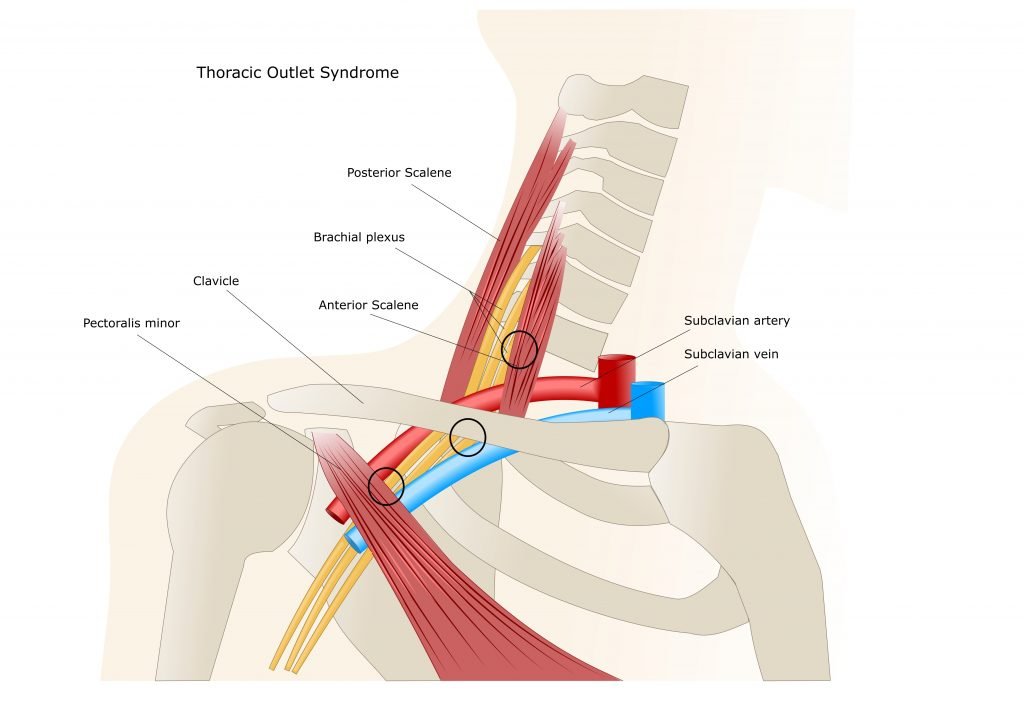Referred Pain into the Hand and Wrist
Another aspect of hand and wrist pain is that pain can often result because of an issue elsewhere. The good news is that most issues are very treatable with osteopathy.
Nerve root impingement from the neck
Typical symptoms: Dull ache, pain and tingling in the neck, shoulder, upper arm and forearm and hand.
These nerves can become trapped for several different reasons and refer to the arm (including the hand) and shoulder.
The areas a single nerve innervates in the arm and shoulder is called a dermatome and each specific nerve will be responsible for sensory perception in different areas (temperature, touch, vibration, pressure and pain). Therefore, if a nerve is impinged in the neck, pain and pins and needles (or paraesthesia) will refer to any given dermatome.
The most common causes of trapped nerves are herniated and bulging discs, spinal stenosis, facet joint arthropathy and degenerative discs.
Our new IDD Therapy programme is effective in treating trapped nerves, is non-invasive (unlike surgery) and is pain-free. IDD Therapy bridges the gap between what manual therapy cannot achieve and surgery. This therapy is the fastest growing therapy for trapped nerves and degenerative disc issues in the UK.
Nerves can also be trapped as they track their way down the arm through various anatomical structures especially at the elbow and palm of the hand (as in Carpal Tunnel Syndrome).
Tennis elbow
Typical symptoms: Gripping causes pain on the outside of the elbow, forearm and into the hand.
Tennis elbow is correctly termed ‘lateral epicondylitis’. The lateral epicondyle is a small bony bump on the outside of your forearm where one of the most important muscle tendons that helps lock your wrist inserts (these are the forearm extensors).
Damage is the consequence of an overuse injury, or repetitive activity, which creates small tears in the tendon. This occurs where the tendon inserts into the surface of the bone (or periosteum) as it attaches to the lateral epicondyle in the elbow joint.
Activities at home like DIY or gardening can precipitate an issue, as grip strength is required to operate most tools (it is no surprise that this condition is frequent in most tradesman such as builders and carpenters). The resulting pain can become obvious even when undertaking the simplest of tasks such as turning a door handle or opening a jar.
Golfer’s elbow
Golfer’s elbow is a condition that causes pain on the inside of your elbow. This is where your flexor tendons for your wrist attach to a bony bump called a medial epicondyle on the inside of your elbow. This is the tendon responsible for bending and locking your wrist in a forward or flexed position.
This condition is not limited to golfers but to people who repeatedly use their wrists in any activity that involves constant wrist flexion. This is an overuse injury and a repetitive activity will lead to small tears in the tendon as it inserts into periosteum (or surface) of the bone on the medial epicondyle on the inside of your elbow.
We use soft tissue techniques and ultrasound to give pain relief. We also administer basic stretching exercises and recommend an epicondylitis strap to help relieve tension on the tendon. For most people this is all that they will require, and pain will last from anything up to twelve weeks.
We also offer Shockwave Therapy which is one of the most advanced non-surgical and non-invasive treatment available for a wide range of stubborn conditions that are difficult to treat using a conventional treatment approach (this includes tennis and golfer’s elbow which can be very difficult to treat). Shockwave Therapy will preclude the need for steroid injections and invasive surgeries and enable rapid relief from your pain.
Thoracic Outlet Syndrome
Thoracic outlet syndrome (TOS) is a compression of nerves and blood vessels in the shoulder and can produce a wide-ranging set of symptoms that typically get worse when the arm is raised.
TOS occurs when blood vessels or nerves in the space between your collarbone and your first rib (this is called the thoracic outlet) become squashed. This anatomical space can be seen in the diagram below.
Thoracic outlet syndrome can cause pain in your shoulders, arm and neck and numbness in your fingers. This can happen for a variety of difference reasons such as a traumatic onset (from a road traffic accident) or it can be sports related, occupational or even variations in your anatomy (some people have an extra rib).
The good news is that in most cases this condition usually responds well to manual therapy.





